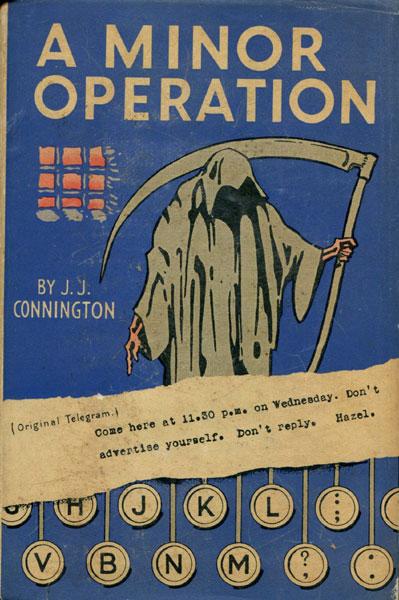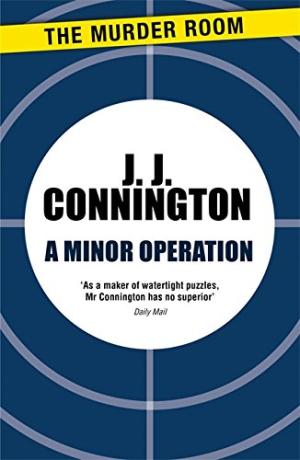 Nicholas Adeney has just been released from prison, but he is not a happy man. His sister, Hazel, married a career villain, Deerhurst, who is about to be released from prison too, and who is determined that matters between himself and Hazel are far from over, no matter what Hazel might think of the situation.
Nicholas Adeney has just been released from prison, but he is not a happy man. His sister, Hazel, married a career villain, Deerhurst, who is about to be released from prison too, and who is determined that matters between himself and Hazel are far from over, no matter what Hazel might think of the situation.
After Deerhurst is released, Hazel disappears in mysterious circumstances, a pool of blood being the only trace that she was ever there. But when a dead body turns up, it doesn’t belong to Hazel, but to Deerhurst himself…
Was Hazel responsible? Did Adeney kill Deerhurst to protect his sister? Or is something else going on entirely?
 My last #1937book for Crimes Of The Century. I was going to take a look at Hamlet, Revenge, so apologies to the Innes fans out there, but inspired by recently reading the Rhode bit of Curtis Evans’ Masters Of The Humdrum Mystery, I thought I’d take a look at the “Humdrum” writer whose books are all readily available as ebooks from the Murder Room imprint, namely J J Connington.
My last #1937book for Crimes Of The Century. I was going to take a look at Hamlet, Revenge, so apologies to the Innes fans out there, but inspired by recently reading the Rhode bit of Curtis Evans’ Masters Of The Humdrum Mystery, I thought I’d take a look at the “Humdrum” writer whose books are all readily available as ebooks from the Murder Room imprint, namely J J Connington.
I’ve enjoyed Connington in the past – Murder In The Maze, The Case With Nine Solutions and The Boathouse Riddle – so I’m slightly perplexed as to why it’s taken me so long to return. I know his writing style can be a little dry (in particularly in The Boathouse Riddle) but these are well-crafted mystery tales. And you know what? I think A Minor Operation is the best of the lot so far.
It’s a relatively simple tale, and does suffer a little from a lack of credible suspects, but the plot mechanics as to what happened to Hazel and Deerhurst are meticulously planned without the reader ever needing a wallchart and post-it notes to work it out. Yes, there is one obvious issue that, if heeded as any normal person would do, would derail the plot entirely, but this is, I thought, really well done.
And the characters aren’t as dry as Connington’s critics might suggest. I enjoyed the local policeman’s sparring with Deerhurst early on, and when Driffield and his chum Squire Wendover get in on the act, the plot bounces along nicely, never really standing still or going in circles like some books I could mention.
As for 1937-ness? Well, everyone is smoking like it’s going out of fashion – this is the second book where the discussion of the characters’ preferred brands of cancer-stick occurs. But there’s no feeling of an imminent war (or a reasonably recent one) although one character is, more than once, compared to a “ship’s captain from the China trade” basically as he has a beard like Captain Birds Eye (the original version, needless to say). Oh, and there’s a bit of typewriter nonsense – can you really tell the brand of typewriter just by looking at something typed by it? Admittedly, it’s less likely than the person from Death In The Hopfields who recognised a fingerprint from over five years previous…
So, with this, my eighth 1937 Book, we draw the month to a close. And what better way to end the month on a classic mystery that is Highly Recommended.
My 1937 Books:
- Death On The Board by John Rhode
- The Cheltenham Square Murder by John Bude
- Tread Softly by Brian Flynn
- Death In The Hopfields by John Rhode
- Mystery Of Mr Jessop by E R Punshon
- Proceed With Caution by John Rhode
- Vintage Murder by Ngaio Marsh
- A Minor Operation by J J Connington
Other 1937 books from me from ages past:
- Death On The Nile by Agatha Christie
- The Ten Teacups by Carter Dickson (and a spoiler-filled review here)
- The Door Between by Ellery Queen
- The Devil To Pay by Ellery Queen
Be back tomorrow to see if anything from 1937 makes it to Book Of The Month – there are some very strong contenders there, as well as some modern day books as well…

I liked your comment about smoking! It sounds very much like a much more recent Greece or France…
LikeLike
Part of the evidence revolves around a smoked cigar and it seems cast-iron that some people just wouldn’t have smoked that as it’s not their brand! Not sure that stands up in court…
LikeLiked by 1 person
“Oh, and there’s a bit of typewriter nonsense – can you really tell the brand of typewriter just by looking at something typed by it?”
I call this Fantastic Forensics ! We have something worse in It Walks By Night by Carr. A document is traced to a particular pencil ! By handwriting analysis it is determined not only that the writer is under the influence of a drug but also the specific drug taken !
LikeLike
Only read the one Connington novel. Feel like I should try him again at some point. Loving the cover art for this novel.
LikeLike
Well, I wish that was my copy…
LikeLike
Almost certainly one could identify a particular brand of typewriter, by the different typefaces and spacing of the keys et cetera in very much the same way that one can identify a specific manufacturer of a gun by looking at the spent bullet using the calibre, the number of twists, and whether they are to the right or to the left. Forensic departments due such things as a matter of course. Perhaps not in every case, but it is by no means an unlikely occurance.
LikeLiked by 1 person
I appreciate that if it is examined forensically. But Sir Clinton Driffield just glances at it, and instantly knows. There are several classic novels where a letter can be traced to a particular machine, but that’s usually due to a dodgy letter. Still, it’s easily overlooked unless you’re a nitpicker like me.
LikeLike
[…] A Minor Operation by J J Connington […]
LikeLike
[…] The Puzzle Doctor’s last was J. J. Connington’s A Minor Operation: […]
LikeLike
[…] A Minor Operation by J J Connington (about £15 for the recent Coachwhip reprint, or a fiver as an ebook) […]
LikeLike
[…] Review 786 – A Minor Operation by J J Connington […]
LikeLike